#automation testing trends
Explore tagged Tumblr posts
Link
Integration of developed technologies including the Internet of Things (IoT), DevOps, and Artificial Intelligence (AI) into the industrial processes,...
#adroit market research#automation testing#automation testing market 2020#automation testing market size#automation testing trends
0 notes
Link
#adroit market research#automation testing#automation testing market 2020#automation testing market size#automation testing trends
0 notes
Text
Automated Testing Software Market Global Industry Analysis | Trends 2025-2033

The Reports and Insights, a leading market research company, has recently releases report titled “Automated Testing Software Market: Global Industry Trends, Share, Size, Growth, Opportunity and Forecast 2025-2033.” The study provides a detailed analysis of the industry, including the global Automated Testing Software Market share, size, trends, and growth forecasts. The report also includes competitor and regional analysis and highlights the latest advancements in the market.
Report Highlights:
How big is the Automated Testing Software Market?
The global automated testing software market was valued at US$ 6.6 billion in 2024 and is expected to register a CAGR of 7.4% over the forecast period and reach US$ 12.6 billion in 2033.
What are Automated Testing Software?
Automated testing software comprises tools and frameworks created to automate the running of tests for software applications. It enables developers and quality assurance teams to efficiently test software functionality, performance, and security by executing pre-scripted tests. This software can mimic user interactions, detect bugs and errors, and provide comprehensive reports on test outcomes. Its use enhances testing speed and accuracy, resulting in quicker development cycles and improved software quality.
Request for a sample copy with detail analysis: https://www.reportsandinsights.com/sample-request/1735
What are the growth prospects and trends in the Automated Testing Software industry?
The automated testing software market growth is driven by various factors and trends. The market for automated testing software is experiencing rapid expansion within the software industry, propelled by the widespread adoption of agile and DevOps methodologies. This market encompasses a range of tools and platforms aimed at automating testing processes, enhancing software quality, and expediting time-to-market. Key drivers of market growth include the increasing requirement for continuous testing, the imperative to cut down testing expenses and time, and the escalating complexity of software applications. Additionally, the market is influenced by the escalating trend of digital transformation across industries, which necessitates dependable testing solutions to ensure software applications' reliability and performance. Hence, all these factors contribute to automated testing software market growth.
What is included in market segmentation?
The report has segmented the market into the following categories:
By Type of Testing:
Functional Testing
Performance Testing
Security Testing
Compatibility Testing
Usability Testing
Others
By Testing Tool:
Test Management Tools
Functional Testing Tools
Performance Testing Tools
Security Testing Tools
Codeless Testing Tools
Others
By Deployment Mode:
On-Premises
Cloud-based
By Organization Size:
Small and Medium-sized Enterprises (SMEs
Large Enterprises
By End-User Industry:
IT and Telecom
BFSI (Banking, Financial Services, and Insurance)
Healthcare
Retail
Manufacturing
Government and Public Sector
Media and Entertainment
Others
Segmentation By Region:
North America:
United States
Canada
Europe:
Germany
The U.K.
France
Spain
Italy
Russia
Poland
BENELUX
NORDIC
Rest of Europe
Asia Pacific:
China
Japan
India
South Korea
ASEAN
Australia & New Zealand
Rest of Asia Pacific
Latin America:
Brazil
Mexico
Argentina
Middle East & Africa:
Saudi Arabia
South Africa
United Arab Emirates
Israel
Who are the key players operating in the industry?
The report covers the major market players including:
IBM Corporation
SmartBear Software
Tricentis
Ranorex GmbH
TestComplete
Selenium
Appium
Sauce Labs Inc.
Parasoft Corporation
Eggplant (formerly TestPlant)
Cigniti Technologies
QualiTest Group
Broadcom Inc. (formerly CA Technologies)
Hewlett Packard Enterprise (HPE)
View Full Report: https://www.reportsandinsights.com/report/Automated Testing Software-market
If you require any specific information that is not covered currently within the scope of the report, we will provide the same as a part of the customization.
About Us:
Reports and Insights consistently mееt international benchmarks in the market research industry and maintain a kееn focus on providing only the highest quality of reports and analysis outlooks across markets, industries, domains, sectors, and verticals. We have bееn catering to varying market nееds and do not compromise on quality and research efforts in our objective to deliver only the very best to our clients globally.
Our offerings include comprehensive market intelligence in the form of research reports, production cost reports, feasibility studies, and consulting services. Our team, which includes experienced researchers and analysts from various industries, is dedicated to providing high-quality data and insights to our clientele, ranging from small and medium businesses to Fortune 1000 corporations.
Contact Us:
Reports and Insights Business Research Pvt. Ltd. 1820 Avenue M, Brooklyn, NY, 11230, United States Contact No: +1-(347)-748-1518 Email: [email protected] Website: https://www.reportsandinsights.com/ Follow us on LinkedIn: https://www.linkedin.com/company/report-and-insights/ Follow us on twitter: https://twitter.com/ReportsandInsi1
#Automated Testing Software Market share#Automated Testing Software Market size#Automated Testing Software Market trends
0 notes
Text
Automation Testing Market Size, Share, Analysis, Forecast, and Growth Trends to 2032: Software Quality Becomes a Strategic Priority
The Automation Testing Market was valued at USD 29.4 billion in 2023 and is expected to reach USD 118.6 billion by 2032, growing at a CAGR of 16.80% over 2024-2032.
The Automation Testing Market is experiencing a transformative shift as businesses increasingly prioritize faster time-to-market and enhanced software quality. Driven by the rising demand for digital transformation and agile methodologies, automation testing has become a critical element in software development lifecycles. Organizations are embracing automated solutions to minimize manual intervention, reduce errors, and ensure consistent performance across platforms.
Automation Testing Market continues to gain traction across sectors such as BFSI, healthcare, retail, telecom, and manufacturing. With the growing complexity of applications and integration of AI and machine learning into testing tools, the market is evolving rapidly. Enterprises are not just automating repetitive test cases but also leveraging intelligent automation to predict defects, improve test coverage, and enhance user experiences.
Get Sample Copy of This Report: https://www.snsinsider.com/sample-request/4127
Market Keyplayers:
Selenium - Selenium WebDriver
Tricentis - Tosca
IBM - Rational Functional Tester
Micro Focus - UFT (Unified Functional Testing)
SmartBear - TestComplete
Cucumber - CucumberStudio
Appium - Appium
Katalon - Katalon Studio
Ranorex - Ranorex Studio
Worksoft - Worksoft Certify
Sahi - Sahi Pro
LambdaTest - LambdaTest
Eggplant - Eggplant Functional
Perfecto - Perfecto Test Automation
TestComplete - TestComplete
Telerik - Test Studio
Sauce Labs - Sauce Labs Selenium Grid
Applitools - Visual AI Testing
Postman - Postman API Testing
Tricentis – qTest
Market Analysis
The automation testing landscape is driven by rapid technological advancements and the increasing need for efficient, error-free deployment processes. Businesses are adopting DevOps and continuous integration/continuous deployment (CI/CD) pipelines, fueling the demand for scalable and flexible testing solutions. Cloud-based testing platforms and open-source tools have further expanded accessibility, enabling SMEs to compete alongside large enterprises. The growth of mobile and web applications has also intensified the requirement for robust cross-platform testing frameworks.
Market Trends
Rise of AI and Machine Learning: Intelligent automation is empowering predictive analytics in testing, enhancing accuracy and speed.
CI/CD Integration: Seamless integration of automation tools into CI/CD pipelines accelerates development cycles.
Cloud-Based Testing: Scalable cloud infrastructure enables remote and parallel testing environments.
Codeless Automation Tools: These tools are lowering the technical barriers, making automation accessible to non-developers.
Increased Adoption in SMEs: Open-source frameworks and SaaS models are driving adoption across small and medium businesses.
Market Scope
Expanding Across Verticals: Automation testing is being adopted in healthcare, eCommerce, BFSI, telecom, and automotive industries.
Global Penetration: North America leads, but Asia-Pacific is emerging rapidly with digitization initiatives.
Beyond Functional Testing: Growth in performance, security, and usability testing automation.
Support for Emerging Tech: Evolving tools support IoT, blockchain, and AR/VR applications.
High ROI Potential: Reduced human error, faster testing cycles, and better product quality.
As the demand for seamless user experiences and reliable digital platforms grows, the market's potential continues to expand. From startups to multinational corporations, the focus on automation is no longer optional but essential.
Market Forecast
The future of the Automation Testing Market is poised for exponential growth, powered by innovation and demand for faster, higher-quality releases. As enterprises transition from legacy testing methods to modern, AI-driven frameworks, automation is expected to redefine how software is built, tested, and delivered. With continuous investments in R&D and vendor competition heating up, the market is set to witness breakthroughs in intelligent test orchestration, self-healing scripts, and hyper-automation capabilities.
Access Complete Report: https://www.snsinsider.com/reports/automation-testing-market-4127
Conclusion
In a world where digital agility defines success, the Automation Testing Market stands as a pivotal force in accelerating innovation. For businesses aiming to stay competitive, embracing automation isn't just a trend—it's a strategic imperative. Whether you're a tech leader, a QA professional, or an enterprise innovator, now is the time to capitalize on the wave of transformation driving this dynamic market forward.
About Us:
SNS Insider is one of the leading market research and consulting agencies that dominates the market research industry globally. Our company's aim is to give clients the knowledge they require in order to function in changing circumstances. In order to give you current, accurate market data, consumer insights, and opinions so that you can make decisions with confidence, we employ a variety of techniques, including surveys, video talks, and focus groups around the world.
Contact Us:
Jagney Dave - Vice President of Client Engagement
Phone: +1-315 636 4242 (US) | +44- 20 3290 5010 (UK)
#Automation Testing Market#Automation Testing Market Scope#Automation Testing Market Share#Automation Testing Market Size#Automation Testing Market Trends
0 notes
Text
Future of Automated Test Equipment: Growth Factors & Challenges
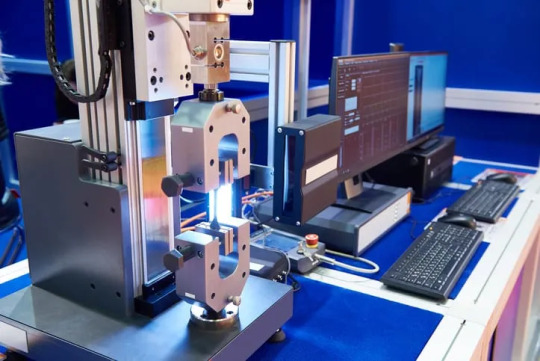
Automated Test Equipment Market: Trends, Growth, Analysis, and Future Outlook
During the projected period, the global Automated Test Equipment market is anticipated to expand at a compound annual growth rate (CAGR) of 3.6% from its 2022 valuation of USD 7.55 billion. An automated test apparatus (ATE) is a computer-controlled system that is used to test and assess electronic systems, parts, and gadgets.
The market's expansion is driven by the consumer electronics industry's increasing need for this equipment as well as the notable manufacturing time savings that result from its utilization. Furthermore, throughout the projection period, the government's initiatives to support the semiconductor sector will open up new avenues for market growth.
Request Sample PDF Copy:https://wemarketresearch.com/reports/request-free-sample-pdf/automated-test-equipment-market/1217
Automated Test Equipment Market Trends and Analysis
The Automated Test Equipment Market is evolving rapidly, driven by various industry trends:
Adoption of AI and Machine Learning – Integration of AI-driven automation improves testing efficiency and accuracy.
Growing Semiconductor Demand – The increase in consumer electronics and automotive electronics fuels market growth.
Expansion of 5G Technology – The proliferation of 5G networks requires advanced testing solutions, boosting ATE demand.
Miniaturization of Electronic Components – Smaller, more complex electronic devices necessitate high-precision automated testing.
Industry 4.0 and IoT Integration – Smart manufacturing and IoT connectivity are driving ATE innovation.
Key Companies
Chroma ATE Inc.
Aeroflex Inc. (a subsidiary of Cobham plc)
Astronics Corporation
Advantest Corporation
LTX-Credence Corporation (Xcerra Corporation)
Teradyne Inc.
STAr Technologies Inc. (a subsidiary of Innotech Corporation)
Tesec Corporation
Roos Instruments, Inc.
Marvin Test Solutions Inc.
Danaher Corporation
Others
Automated Test Equipment Market Growth Factors
The Automated Test Equipment Market Growth is propelled by several factors:
Increasing Complexity of Semiconductor Devices – As chips become more advanced, the need for efficient testing grows.
Rising Demand in Consumer Electronics – Smartphones, wearables, and smart home devices require high-quality testing.
Automotive Industry Expansion – The rise of electric vehicles and ADAS systems increases ATE adoption.
Cost Reduction in Manufacturing – Automated testing improves efficiency and reduces production costs.
Government and Regulatory Standards – Compliance with quality and safety regulations boosts market demand.
Key Points of the Automated Test Equipment Market
Market Size & Share: The Automated Test Equipment Market Size is expanding due to rising industrial demand.
Market Price: Cost varies based on equipment type, technology, and application.
Market Forecast: The industry is projected to experience steady growth, particularly in semiconductors and telecom sectors.
Market Potential: High potential in emerging markets, including automotive and IoT applications.
Market Segments
By Product • Non-Memory ATE • Memory ATE • Discrete
By Vertical • Automotive • Consumer • Aerospace & Defense • IT & Telecom • Others
By Geography • North America o U.S. o Canada o Mexico
Europe o U.K. o Germany o France o Italy o Spain o Russia
Asia-Pacific o Japan o China o India o Australia o South Korea o ASEAN o Rest of APAC
South America o Brazil o Argentina o Colombia o Rest of South America
MEA o South Africa o Saudi Arabia o UAE o Egypt o Rest of MEA
Benefits of This Automated Test Equipment Market Report
This report provides comprehensive insights into:
Current and Emerging Market Trends – Understanding industry shifts and technological advancements.
Competitive Landscape – Analysis of key market players and their strategies.
Innovations in Testing Technologies – Overview of AI, ML, and IoT-driven ATE solutions.
Investment Opportunities – Identifying lucrative segments within the market.
Regulatory Compliance and Challenges – Navigating industry standards and market constraints.
Challenges in the Automated Test Equipment Market
Despite promising growth, the Automated Test Equipment Market faces challenges:
High Initial Investment Costs – Advanced ATE solutions can be expensive for smaller manufacturers.
Rapid Technological Advancements – Keeping up with fast-paced innovations is a challenge for businesses.
Lack of Skilled Workforce – The need for highly trained personnel to operate complex ATE systems.
Supply Chain Disruptions – Component shortages and geopolitical factors affecting production.
Regulatory Compliance Issues – Ensuring adherence to international safety and quality standards.
FAQs About the Automated Test Equipment Market
What is the current Automated Test Equipment Market Size?
What factors contribute to Automated Test Equipment Market Growth?
How does the Automated Test Equipment Market Price vary?
Which industries benefit the most from the Automated Test Equipment Market?
What are the latest Automated Test Equipment Market Trends?
What is the Automated Test Equipment Market Forecast for the next decade?
Related Report
Solid State Battery Market
https://wemarketresearch.com/reports/solid-state-battery-market/90
Personal Protective Equipment Market
https://wemarketresearch.com/reports/personal-protective-equipment-market/1321
Automated Test Equipment Market
https://wemarketresearch.com/reports/automated-test-equipment-market/1217
Conclusion
The Automated Test Equipment Market plays a vital role in ensuring the quality and reliability of modern electronic devices. With growing Automated Test Equipment Market Demand in industries such as semiconductors, consumer electronics, and automotive, the market is set for steady expansion. However, challenges such as high investment costs and rapid technological evolution need to be addressed. By embracing innovations and strategic investments, businesses can capitalize on the opportunities within this dynamic market.
#Automated Test Equipment Market#Global Automated Test Equipment Market#Automated Test Equipment Industry#Automated Test Equipment Market 2023#Automated Test Equipment Share#Automated Test Equipment Trends#Automated Test Equipment Top Key Players#United States Automated Test Equipment Market#United Kingdom Automated Test Equipment Market#Germany Automated Test Equipment Market#South Korea Automated Test Equipment Market#Japan Automated Test Equipment Market#Automated Test Equipment Segmentations#Automated Test Equipment Types#Automated Test Equipment Applications
0 notes
Text
Low-Code vs. No-Code Automation Testing: Choosing the Right Tool for Your QA Success
Low-Code vs. No-Code Automation Testing Tools Choosing the right automation testing tool can revolutionize your software quality assurance process. Low-code tools offer flexibility with minimal coding, perfect for complex workflows, while no-code tools empower non-technical users to automate effortlessly. When it comes to the best platform, Assure QA stands out. With expertise in functional, automation, performance, and security testing, Assure QA provides robust, high-performing solutions tailored to your needs. Its intuitive platform allows you to create reusable, scalable tests and offers seamless integration with CI/CD pipelines. Simplify your automation journey with Assure QA\u2014your trusted partner for exceptional software quality assurance.


#Low-Code vs. No-Code#Automation Testing Tools#Software Quality Assurance#No-Code Testing Solutions#Low-Code Automation Testing#QA Automation Trends
0 notes
Text
Automated Testing the Future of Software Testing
Explore how automated testing is revolutionizing software quality assurance, enhancing efficiency and accuracy in today’s digital landscape.
In the hastily evolving landscape of software development, the need for green and reliable checking out methods has by no means been greater. As packages grow to be more complicated and necessary to our day by day lives, the demand for first-rate warranty has surged. Enter automated testing—a modern solution that is reworking the way software program is tested. This blog explores the evolution,…

View On WordPress
#Agile Development#AIin Testing#Automated Testing#Cloud Testing#Continuous Testing#Quality Assurance#Software Testing#Tech Trends#Test Strategy#Testing Automation
0 notes
Text
Skills Required for QA Professionals in QA Automation
Here are some essential skills required for QA Automation:
Programming Languages: Proficiency in at least one programming language such as Java, Python, JavaScript, or others commonly used in test automation.
Test Automation Tools/Frameworks: Experience with popular automation frameworks like Selenium WebDriver, Appium (for mobile testing), or tools like Cypress, TestComplete, or Robot Framework.
Version Control Systems: Knowledge of version control systems like Git for managing test scripts and collaborating with teams.
Web Technologies: Understanding of web technologies (HTML, CSS, JavaScript) to interact with elements on web applications.
API Testing: Ability to automate testing of APIs using tools like Postman, RestAssured, or libraries in programming languages.
Database Skills: Basic knowledge of SQL for verifying data integrity and performing backend testing.
Testing Concepts: Strong understanding of software testing concepts, types of testing (functional, regression, load, etc.), and best practices.
CI/CD Tools: Familiarity with Continuous Integration and Continuous Deployment tools like Jenkins, Travis CI, or GitLab CI for automating test execution.
Problem-Solving Skills: Ability to analyze complex problems and provide solutions within the automation framework.
Communication: Good communication skills to collaborate with developers, testers, and other stakeholders.
Agile Methodology: Understanding of Agile practices and how automation fits into Agile development cycles.
Attention to Detail: Thoroughness in writing test scripts, handling edge cases, and ensuring comprehensive test coverage.
These skills collectively enable QA Professionals to effectively create, execute, and maintain automated test suites that ensure the quality and reliability of software applications. Learn QA Automation Skills to pave your way to becoming a successful QA professional.
#automation testing#automation testing tools#automation testing training#automation training#tech trends#technology#software testing#qa automation
0 notes
Link
#adroit market research#automation testing#automation testing market 2020#automation testing market size#automation testing trends
0 notes
Text
Future Of AI In Software Development

The usage of AI in Software Development has seen a boom in recent years and it will further continue to redefine the IT industry. In this blog post, we’ll be sharing the existing scenario of AI, its impacts and benefits for software engineers, future trends and challenge areas to help you give a bigger picture of the performance of artificial intelligence (AI). This trend has grown to the extent that it has become an important part of the software development process. With the rapid evolvements happening in the software industry, AI is surely going to dominate.
Read More
#Accountability#Accuracy Accuracy#Advanced Data Analysis#artificial intelligence#automated testing#Automation#bug detection#code generation#code reviews#continuous integration#continuous deployment#cost savings#debugging#efficiency#Enhanced personalization#Ethical considerations#future trends#gartner report#image generation#improved productivity#job displacement#machine learning#natural language processing#privacy privacy#safety#security concerns#software development#software engineers#time savings#transparency
0 notes
Text
Automated Testing Software Market Global Industry Analysis | Trends 2025-2033
The Reports and Insights, a leading market research company, has recently releases report titled “Automated Testing Software Market: Global Industry Trends, Share, Size, Growth, Opportunity and Forecast 2025-2033.” The study provides a detailed analysis of the industry, including the global Automated Testing Software Market share, size, trends, and growth forecasts. The report also includes competitor and regional analysis and highlights the latest advancements in the market.
Report Highlights:
How big is the Automated Testing Software Market?
The global automated testing software market was valued at US$ 6.6 billion in 2024 and is expected to register a CAGR of 7.4% over the forecast period and reach US$ 12.6 billion in 2033.
What are Automated Testing Software?
Automated testing software comprises tools and frameworks created to automate the running of tests for software applications. It enables developers and quality assurance teams to efficiently test software functionality, performance, and security by executing pre-scripted tests. This software can mimic user interactions, detect bugs and errors, and provide comprehensive reports on test outcomes. Its use enhances testing speed and accuracy, resulting in quicker development cycles and improved software quality.
Request for a sample copy with detail analysis: https://www.reportsandinsights.com/sample-request/1735
What are the growth prospects and trends in the Automated Testing Software industry?
The automated testing software market growth is driven by various factors and trends. The market for automated testing software is experiencing rapid expansion within the software industry, propelled by the widespread adoption of agile and DevOps methodologies. This market encompasses a range of tools and platforms aimed at automating testing processes, enhancing software quality, and expediting time-to-market. Key drivers of market growth include the increasing requirement for continuous testing, the imperative to cut down testing expenses and time, and the escalating complexity of software applications. Additionally, the market is influenced by the escalating trend of digital transformation across industries, which necessitates dependable testing solutions to ensure software applications' reliability and performance. Hence, all these factors contribute to automated testing software market growth.
What is included in market segmentation?
The report has segmented the market into the following categories:
By Type of Testing:
Functional Testing
Performance Testing
Security Testing
Compatibility Testing
Usability Testing
Others
By Testing Tool:
Test Management Tools
Functional Testing Tools
Performance Testing Tools
Security Testing Tools
Codeless Testing Tools
Others
By Deployment Mode:
On-Premises
Cloud-based
By Organization Size:
Small and Medium-sized Enterprises (SMEs
Large Enterprises
By End-User Industry:
IT and Telecom
BFSI (Banking, Financial Services, and Insurance)
Healthcare
Retail
Manufacturing
Government and Public Sector
Media and Entertainment
Others
Segmentation By Region:
North America:
United States
Canada
Europe:
Germany
The U.K.
France
Spain
Italy
Russia
Poland
BENELUX
NORDIC
Rest of Europe
Asia Pacific:
China
Japan
India
South Korea
ASEAN
Australia & New Zealand
Rest of Asia Pacific
Latin America:
Brazil
Mexico
Argentina
Middle East & Africa:
Saudi Arabia
South Africa
United Arab Emirates
Israel
Who are the key players operating in the industry?
The report covers the major market players including:
IBM Corporation
SmartBear Software
Tricentis
Ranorex GmbH
TestComplete
Selenium
Appium
Sauce Labs Inc.
Parasoft Corporation
Eggplant (formerly TestPlant)
Cigniti Technologies
QualiTest Group
Broadcom Inc. (formerly CA Technologies)
Hewlett Packard Enterprise (HPE)
View Full Report: https://www.reportsandinsights.com/report/Automated Testing Software-market
If you require any specific information that is not covered currently within the scope of the report, we will provide the same as a part of the customization.
About Us:
Reports and Insights consistently mееt international benchmarks in the market research industry and maintain a kееn focus on providing only the highest quality of reports and analysis outlooks across markets, industries, domains, sectors, and verticals. We have bееn catering to varying market nееds and do not compromise on quality and research efforts in our objective to deliver only the very best to our clients globally.
Our offerings include comprehensive market intelligence in the form of research reports, production cost reports, feasibility studies, and consulting services. Our team, which includes experienced researchers and analysts from various industries, is dedicated to providing high-quality data and insights to our clientele, ranging from small and medium businesses to Fortune 1000 corporations.
Contact Us:
Reports and Insights Business Research Pvt. Ltd. 1820 Avenue M, Brooklyn, NY, 11230, United States Contact No: +1-(347)-748-1518 Email: [email protected] Website: https://www.reportsandinsights.com/ Follow us on LinkedIn: https://www.linkedin.com/company/report-and-insights/ Follow us on twitter: https://twitter.com/ReportsandInsi1
#Automated Testing Software Market share#Automated Testing Software Market size#Automated Testing Software Market trends
0 notes
Text
Maneuvering Selenium Automation Complexities: Refining your Testing Process
Selenium has managed to carve a solid reputation in the terrain of test automation, endowing both developers and testers with the ability to perform extensive web application testing across myriad browsers and operating systems. However, with such extensive capability comes an array of complex challenges. Be it wrangling with constantly evolving web interfaces or ensuring seamless testing flows across various browsers, Selenium's journey is riddled with obstacles. For those striving to triumph over these Selenium inherited hurdles and polish their testing skills, participating in a notable Selenium training program in Pune could be a potential solution. Such programs serve as a rich reservoir of knowledge and qualifications, preparing you to smoothly sail the rough waters of testing, refine your maintenance strategies, and effectively strengthen your test suites' reliability and performance. In this comprehensive guide, let's uncover the common stumbling blocks of Selenium automation and discuss strategies to outsmart them, thereby elevating your testing pursuits.

Bumps on the Road: Test Instability
One common roadblock in the Selenium landscape is the unpredictable aspect of test results. Tests can fail sporadically due to timing disparities, asynchronous page loadings, or varying element identifiers. Managing these inconsistencies can be resource-intensive and may cast a cloud of uncertainty over the reliability of your tests.
Jumping Over Hurdles: Browser Compatibility
The path to flawless test execution across an array of browsers comes with its share of difficulties. Despite Selenium's wide range of browser support, discrepancies in page renditions and interactions can throw off test homogeneity. It requires meticulous planning and execution to ensure consistent test results across different browser environments.
Digging Through the Sand: Web Element Detection
The crux of stable test scripting revolves around the crucial process of identifying web elements. But in the fast-paced world of dynamic web applications, where elements frequently change identities, crafting effective element detectors is anything but an easy task. Strategic approaches need to be established, leveraging unique markers and selector capabilities to secure dynamic element interactions.
Taming the Beast: Asynchronous Operations
The modern web's inclination towards asynchronous JavaScript for real-time content updates often clashes with Selenium's synchronous nature, resulting in potential timing issues. This calls for strategic synchronization methods, incorporating explicit waits to confirm element readiness before proceeding with scripts.

Stepping Up to the Plate: Test Maintenance
Given the ever-evolving nature of web applications, maintaining test scripts becomes a daunting task. This is particularly true for larger Selenium test suites, as they require continual updates to reflect UI or functional changes. Investing in efficient test maintenance practices, including regular code reviews and regression testing, is paramount for ensuring your test suite's sustainability. Consider joining a Selenium Online Training course for in-depth knowledge on test maintenance and assuring your automated testing suite's reliability.
Selenium's Kryptonite: Performance Testing
As much as Selenium excels in functional testing, performance testing such as load tests demands additional tools and frameworks to accurately depict wide-ranging user interactions. The integration of performance testing within your Selenium workflow is crucial for assessing how your system responds and scales under various conditions.
Ensuring Smooth Transitions: Continuous Integration (CI) Strategies
Incorporating Selenium tests into Continuous Integration pipelines calls for careful orchestration to enable efficient test execution and timely feedback. This includes seamless integration with CI tools, effective management of test environments, and clear communication of outcomes, all essential for optimizing your automation processes for continuous delivery goals.
Navigating the Unexpected: Pop-Ups and Alerts
Unexpected browser pop-ups, JavaScript alerts, or dialogs can pose a challenge since Selenium lacks built-in features to handle these. Incorporating robust error-handling strategies within scripts can alleviate this issue, preventing test interference and allowing for graceful failure.
Stretching the Boundaries: Test Scalability
Expanding the scope of Selenium tests to encompass an extensive range of user scenarios and digital environments comes with its own set of challenges. This is particularly true in the context of large, distributed applications. Practices promoting modularization of tests and parallel execution are key to achieving scalability without compromising on testing accuracy.
In conclusion, gaining mastery over Selenium automation calls for a blend of technical knowledge, effective practices, and a solution-focused mindset to overcome common hurdles. Comprehending these obstacles and implementing suitable countermeasures can empower you to enhance your testing proficiency and consistently deliver high-grade software.
#selenium#selenium training#automation#automation testing#selenium test automation#selenium course#programming#qualityassurance#trends
0 notes
Text
Selenium in Focus: Weighing the Pros and Cons for Successful Test Automation
In the realm of software testing, automation is key to enhancing efficiency, broadening coverage, and accelerating delivery times. Among the variety of automation tools available, Selenium stands out due to its endearing popularity, flexible features, and hardy capabilities. However, understanding that no one tool can be a panacea for all types and stages of testing is crucial. Considering your interest in mastering Selenium, I highly recommend enrolling in the Selenium Course in Bangalore. This comprehensive program will equip you with the essential skills and practical knowledge needed to excel in selenium testing. So, in this blog post, we'll put Selenium under the microscope, weighing its pros and cons, to help you make an informed decision for successful test automation.

The Upside of Selenium
Open Source
Foremost, Selenium is an open-source tool. Being free-of-charge paves the way for businesses to have a cost-effective test automation solution. Furthermore, constant updates and improvements from the vast community of Selenium developers keep the tool attuned to evolving needs.
Extensive Browser Compatibility
One of Selenium's shining features is its wide compatibility with all major browsers - Chrome, Firefox, Safari, and Internet Explorer. This allows test scripts created once to be executed across different browsers, ensuring your web application functions seamlessly everywhere.
Broad Language Support
Unlike some other testing tools that demand a specific scripting language, Selenium offers the freedom to write test scripts in several languages like Python, Ruby, C#, Java, and JavaScript. This flexibility allows testers to leverage their existing programming skills, making the switch to Selenium smoother.
Framework and Tool Integration
Integration is key in the modern testing environment where continuous delivery is the goal. Selenium can be comfortably coupled with testing frameworks like TestNG or JUnit for managing test suites and generating reports. It also pairs well with Maven, Jenkins, and Docker for continuous delivery.
Parallel Testing with Grid
Selenium's utility is not confined to testing individual applications. With Selenium Grid, you can undertake parallel and distributed testing across different machines concurrently. This significantly compresses the time needed for executing large test suites, speeding up your delivery cycle.
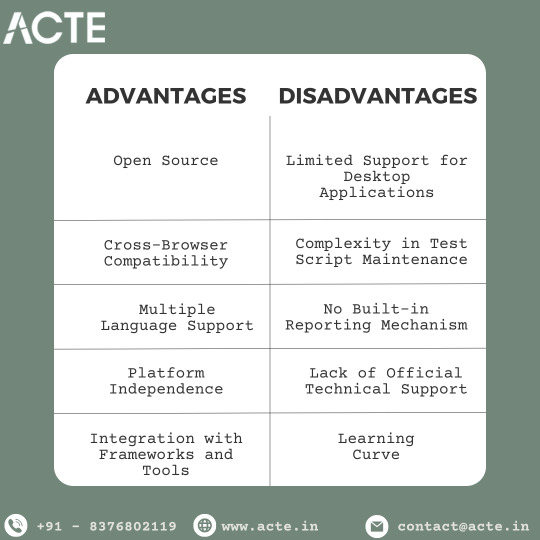
The Flipside of Selenium
While Selenium holds many advantages, it's prudent to remember that it does come with its set of limitations.
Steep Learning Curve
Although versatile, Selenium possesses a steep learning curve, especially for beginners. Comprehensive understanding of APIs, developing testing frameworks, and in-depth knowledge of multiple programming languages is essential to unlock its full potential.
Limited Support for Mobile Applications
While Selenium is unrivaled for automating web applications, when it comes to mobile applications, it lags. Tools specifically designed for mobile test automation like Appium will be necessary to fill the gap.
No Built-in Reporting Facility
Selenium's core focus is on automating web browsers, and as such, it does not inherently provide a reporting facility for recording the outcome of test cases. To overcome this, it must be integrated with third-party tools like TestNG or Extent Reports.
Dynamic Content can Cause Issues
Web content, which dynamically changes with each access, can be difficult to automate using vanilla Selenium, as locators may change with each session. While there are workarounds available, automating such cases can be challenging.
Frequent Updates
Given its open-source status, Selenium receives frequent updates from the community, which can sometimes lead to instability and necessitate regular maintenance of test scripts and environments.
Wrapping It Up
Reflecting on Selenium's pros and cons, what emerges is a picture of a robust, versatile automation tool well suited for a wide array of testing situations. Still, it's equally clear that Selenium needs to be used sensibly, considering project needs, the skillset of the team, and the specific context.
Test automation is never a one-size-fits-all solution, and Selenium is no exception. Therefore, it's significant to be mindful of Selenium's limitations while leveraging its strengths. The users need to supplement Selenium's abilities where necessary, either via additional tools or frameworks.
By considering both the pros and cons that come with Selenium, teams can ensure they're choosing a testing automation solution, which is not only robust and versatile but complements their project needs and team strengths. This approach will pave the way for more efficient, effective test automation, leading to high-quality software delivered faster and more consistently.
#tech#selenium#selenium training#selenium testing#selenium automation#automation testing#software testing#education#trending#writers on tumblr
0 notes
Text
Top 8 Intelligent Test Automation Trends To Look For in 2023

Intelligent Test Automation is the new fuel to software testing – the use of Analytics, Artificial Intelligence, and Machine Learning makes smarter and intelligent decisions at a higher efficiency. To be future ready, you need to embrace innovative and intelligent trends and tools.
Now before we dive into the intelligent testing tools, we need to understand what are the latest trends in testing and why we need these.
This is the first article in the series that covers the trends, and then the second article covers the tools that will help us.
The Changing Landscape of Software Testing
From being a standalone activity at the end of the development cycle, Testing has come a long way and now it’s embedded throughout the software development pipeline. Time to market is a key imperative to succeed in today’s competitive world. Any tool can help you test your application, but there is more to effective testing than that.
The future of effective testing is dominated by the recent technological advancements in Artificial Intelligence (AI), Machine Learning (ML) and insight-driven methods that help you right from the planning stage till execution. With rapid advancements in AI and ML, the future of testing is also evolving.
Today’s business needs
Today’s businesses have realized that using AI-ML powered Test Automation Tools have major impacts on the business outcomes, they are time saving and help you with faster and better quality releases. The trends and tools will help you and the business by:
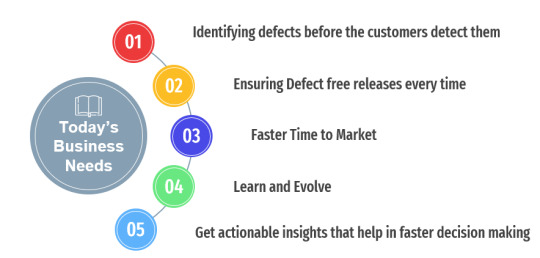
The current trends in AI Testing
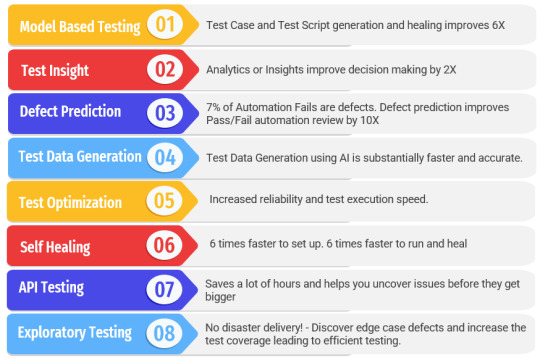
Here are the current trends in AI testing that help deliver the business needs along with the delivery of flawless applications and enhanced user experience.
1. Model Based Testing continues to get better and better, decreasing the effort needed to create and maintain automation.
This is an application of model-based design where test scripts are automatically generated, executed, and checked based on formal specifications of the system under test.
Impact – Test Case and Test Script generation and healing improves 6X
2. Test Insight is moving into mainstream and can help you shape and measure your testing efforts, quality and product life cycle.
They help you with test insights into the entire CI/CD pipeline to understand the impact every change is having on the product and provide guidance and strategic benefits to test management.
Impact – Test Analytics or Insights improve decision making by 2X
3. Defect Prediction can help you save enormous amounts of time in diagnosing and triaging automation Pass/Fail.
Quality comes when you have proper defect triaging/reporting and no noise. The AI tools share an in-depth analysis of automation failures to help the teams reduce their triage time
Impact – 7% of Automation Fails are defects. Defect prediction improves Pass/Fail automation review by 10X
4. Test Data Generation is the biggest challenge for ensuring an excellent testing process and many companies have been focused in this area and rapid advancements are being achieved. With the power of AI and analytics, you can generate data that comes as close as possible to your production data without revealing any sensitive information.
The AI based tools help you analyze a UI and identify a series of test cases that predict the user behavior. It also updates your test data based on newly added functionalities to the system along with the ability to identify and prioritize the test cases for execution.
Impact – Test Data Generation using AI is substantially faster and accurate.
5. Test Optimization is making the test process efficient without any quality compromises.
To speed up and optimize the testing in agile and DevOps environments, World Quality Report recommends a new option – the use of AI to optimize test cases.
AI systems are ideal for determining the area to test as well as the method to test and to failover.
Impact – Increased reliability and test execution speed.
6. Self Healing is the need of the hour as It helps teams to move from defect-based resolution to real-time issue resolution. It’s the ability to update the test cases and test scripts when the UI or API changes.
The complexity of applications increases exponentially as new features are added to the existing functionality. The AI ML power combo can learn if there is a change made, and then automatically modify the test automation script to fix the problem.
Impact – 6 times faster to set up. 6 times faster to run and heal
7. API Testing is the latest trend in the testing community with organizations moving to cloud computing. as it emphasizes the testing of business logic, data responses and security, and performance bottlenecks. With teams moving to microservices architecture, the usage and testing of APIs are on the rise.
Impact – Saves a lot of hours and helps you uncover issues before they get bigger
8. Exploratory Testing has gathered momentum in recent years as it can help testers explore the application beyond the limits of scripted tests.
Exploratory Testing helps to reveal bugs that would go undiscovered during the structured phase of testing. It’s a simultaneous process where you can perform test design and test execution at the same time.
Impact – No disaster delivery! – Discover edge case defects and increase the test coverage leading to efficient testing.
Here’s an interesting whitepaper that talks about the software testing trends forecast and euphoria around Artificial Intelligence – Hype versus Reality. Along with the overall trends of Intelligent Test Automation that we just talked about, the paper dives into the insights and innovations developed by technologically dexterous companies and provides our estimate of the impact that using AI would have in the near term.
Conclusion
With applications becoming complex, teams often struggle with multiple challenges. For example, testing teams need to work collaboratively with the development team on every product release, identifying issues, and fixing them within timelines. With the world moving toward Agile and DevOps, the scalability to changing requirements becomes slow with inefficiencies and delays as teams lack necessary new-age technological skill sets.
With every organization embracing Artificial Intelligence and Machine Learning technologies, CI/CD model, Agile and DevOps practices across all domains, the push for high quality product releases through rapid release cycles are at an all time high. Hence, these next-generation trends are exceedingly important for teams and organizations to accelerate the testing process.
Now that you are aware of the latest trends, let’s look at the innovative tools that will help you jump start your testing.
If this has piqued your interest and you want to know more, then please click here and schedule a demo, or reach out to us at [email protected].
If you like this blog series please like/follow us Webomates or Aseem.
0 notes
Text



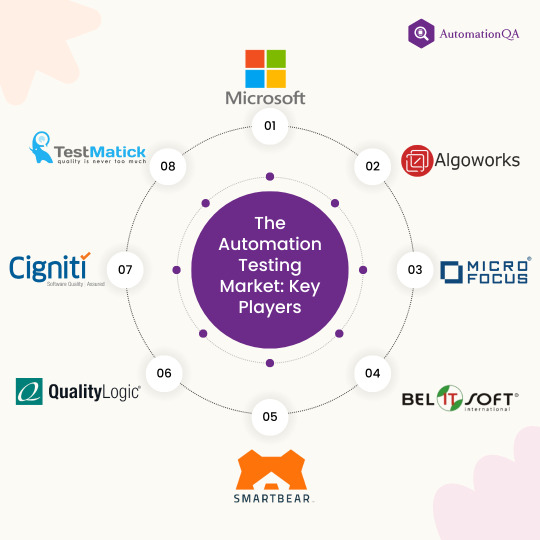
Dive into the Future of Automation Testing! 🚀📊 Uncover the Market Insights for Customized Automation Testing – from size and trends to challenges and projections.
Let's explore what the future holds for automated testing! 💡🌐
1 note
·
View note
Text

CICD introduces agile practices to the product development culture and brings in interesting features like automated builds, automated testing, continuous integration, and continuous testing. The CICD pipeline is a significant feature of the broader DevOps/ DevSecOps framework.
#technology#digital transformation#tech#it consulting#it services#mobile app developers#software development#technology trends#cicd#ci cd tools#product development service#automated testing#cicd pipeline
0 notes